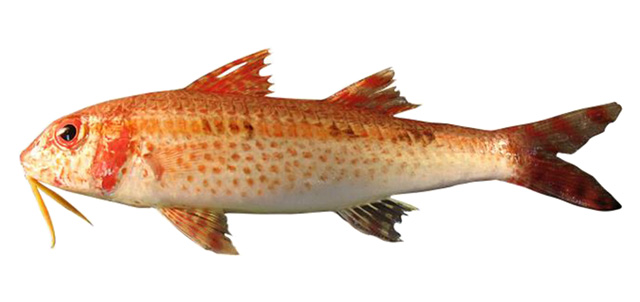|
Dorsal spines (total): 7-8; Dorsal soft rays (total): 9-9. This species is distinguished by the following characters: D VII or VIII + 9, with the first spine minute in 8-spined fish; pectoral fins 13-15; gill rakers 4-6 + 15-18 = 21-24; lateral-line scales 28-30. All measurements in % SL, adults: body depth at first dorsal-fin origin 22-26; body depth at anus 18-22; caudal-peduncle depth 9.2-11; caudal-peduncle width 3.5-5.0; maximum head depth 19-23; head depth through eye 15-18; suborbital depth 8.3-11; interorbital length 7.2-9.2; head length 27-31; snout length 9.7-13; postorbital length 10-13; orbit length 5.9-8.3; upper-jaw length 9.4-13; barbel length 16-20; interdorsal distance 13-17; caudal-peduncle length 22-26; caudal-fin length 27-32; anal-fin height 15-19; pelvic-fin length 19-23; pectoral-fin length 19-22; pectoral-fin width 3.4-4.7; first dorsal-fin height 18-23; second dorsal-fin height 16-20. All measurements in % SL, subadults: body depth at first dorsal-fin origin 22-24; body depth
at anus 18-21; caudal-peduncle depth 9.1-10; caudal-peduncle width 3.6-3.8; maximum head depth 19-21; head depth through eye 15-18; suborbital depth 9.0-10; interorbital length 7.6-8.1; head length 29-30; snout length 11-12; postorbital length 11-13; orbit length 7.8-7.9; upper-jaw length 9.9-12; barbel length 18-19; interdorsal distance 12-14; caudal-peduncle length 22-25; caudal-fin length 29-31; anal-fin height 16-19; pelvic-fin length 21-22; pectoral-fin length 21; pectoral-fin width 3.8-4.2; first dorsal-fin height 21-22; second dorsal-fin height 17-20. Colouration: head and body are red dorsally, brown or dark-grey mottled, ventrally white, often with pale beige or grey dots or red blotches (inactive, live fish with large red patches and broad vertical or oblique red bands on body); the upper lobe of caudal fin with 4-6 red or brown bars (3 or 4 bars in subadults), while the lower caudal-fin lobe with 5-7 (3-5) red, brown or dark-brown bars, usually crossed, entirely or ony dorsally, by a yellow, beige, pale red or pale brown stripe; bars on both lobes of pupil width or less in adults, interrupted by pale, partly hyaline interspaces of similar width or slightly narrower; the lower caudal-lobe tip sometimes black; barbels are entirely yellow; with a single yellow, beige, or pale brown mid-lateral body stripe of pupil width from snout tip through eye to caudal-fin base; the stripe sometimes covered by 1-4 sections with 1-4 dark dots, the posteriormost group of dots behind second dorsal-fin base, often connecting to a dark saddle behind second dorsal fin; the first dorsal fin with 3-4 often fused, pale-red, pale-brown or beige stripes, the fin-tip area not darker pigmented while the second dorsal fin has 3-4 red or brown well-separated stripes with hyaline interspaces; pectoral fins hyaline, pelvic and anal fins weakly pigmented and partly hyaline; preserved fish is pale brown, often with remains of dark pigmentation deriving from caudal-fin bars, mid-lateral dots, saddle and/or second dorsal-fin distal stripe (Ref. 121834). |

